Books by Van Kelly
Pascalian Fictions: Antagonism and Absent Agency in the Wager and Other Pensées
Birmingham, AL: Summa Publications, Jan 1, 1992
Epic and Epoch: Essays on the Interpretation and History of a Genre
Texas Tech University Press, 1994
Special Issues by Van Kelly
Cinéma engagé: Activist Filmmaking in French and Francophone Contexts
South Central Review , 2000
Literature Between Philosophy and History: In Memoriam, Édouard Morot-Sir, 1910-1993
Romance Notes, Jan 1, 1995
Digital Humanities Presentation by Van Kelly

“Transmission of Heritages, Faces, and Obsessions in Colonial/Decolonial Story-Telling"
KU Institute of Digital Humanities Digital Forum , 2017
This joint presentation explores how digital collection and analysis of graphics, of images and o... more This joint presentation explores how digital collection and analysis of graphics, of images and of language shift the way scholars approach story-telling and production of knowledge about legends and histories of non-Western cultures. French novelist J.-M. G. Le Clézio (the 2008 Nobel laureate), and Chris Abani, Nigerian-born novelist and poet, use an Igbo cultural phenomenon, “Igbuichi”/”to cut ichi,” to map nonlinear narratives about their interactions with fathers and cultures. “Cutting itchi,” says Abani in The Face: Cartography of the Void (2013), is the “old practice that has mostly died out” (57) of ritual facial scarifications symbolizing sun, moon, and falcon, among Umundri princes between the Niger and Cross Rivers in Nigeria. Le Clézio in Onitsha (1991) and The African (2004) explores the year he spent as a boy, after World War II, in Ogoja, Nigeria. Le Clézio’s father, a doctor in British colonial service, had as friend an Oxford-trained ethnographer, M. D. W. Jeffreys, who studied Umundri culture and the ichi, which he tied to the hypothesis of a migration of ancient black Nubian pharaohs, and of Egyptian knowledge, from the Nile to the Niger River. Le Clézio and Abani deploy images of the ichi to trace their difficult relationship with self and with violent, authoritarian fathers.
Book chapters by Van Kelly
L’illisibilité en questions. B. Gorillot and A. Lescart, eds. Lille, France: Presses du Septentrion, 2014
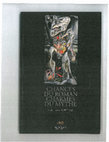
In Marie-Hélène Boblet, eds. Chances du roman, charmes du mythe. Paris: Presses de la Sorbonne Nouvelle, 2013
In his recent novel Ourania, published in 2006, J-M. G. Le Clézio revisits a leitmotiv that has p... more In his recent novel Ourania, published in 2006, J-M. G. Le Clézio revisits a leitmotiv that has profoundly marked his novelistic production since the 1980's, the survival (or failure) of myth, legends, and the sacred in a modern world galvanized by profane and secular elements, and seemingly indifferent, if not hostile, to charismatic spiritual gifts. The protagonist Daniel Sillitoe, a young apprentice geographer, travels to Michoacán to study the volcanic terrain of the Río Tepalcatepec, but he defers completion of his scientific work in order to explore, instead, the human geography of the Valley, where he witnesses the conflict of local agro-industrial potentates with a small commune or intentional community, Campos, led by an elder, Jadi, who represents deep symbolic ties with the oppressed indigenous peoples of the Americas, but who, in the person of the character Raphaël, fails to find a charismatic successor to lead the community forward after his death. The analysis of Daniel's interactions with the diverse milieus of the Valley reveals Le Clézio's attempt to formulate a rational ethics, distinct from revelation, that will allow his characters and readers to live ethically in a postmodern and postcolonial world where myth is endangered but survives thanks to the sensibilities of those still attuned to its reverberations.
In Mémoires occupées: Fictions françaises et Seconde Guerre mondiale. Marc Dambre, Christopher D. Lloyd, Richard J. Golsan, eds, 2013
Une tension fondamentale traverse le roman HHhH de Laurent Binet. Devons-nous imaginer une des pl... more Une tension fondamentale traverse le roman HHhH de Laurent Binet. Devons-nous imaginer une des plus grandes actions de la Résistance européenne, soixante-dix ans après, comme si nous y étions, sur le mode de la communion et de l’envoûtement littéraires ? Ou, au contraire, écrire l’Opération Anthropoïde, « l’extraordinaire histoire de l’attentat organisé contre Heydrich le 27 mai 1942 par des parachutistes tchécoslovaques venus de Londres », nécessite-t-il le recours « psychorigide » au détail exact, au document vérifié ?
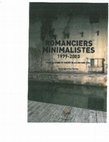
Romanciers minimalistes 1979-2003. Marc Dambre and Bruno Blanckeman, eds.. Colloque de Cerisy. Paris: Presses de la Sorbonne Nouvelle, 2012
Agnès Varda – dans Les Glaneurs et la glaneuse – et Jean Echenoz – dans la quasi totalité de sa p... more Agnès Varda – dans Les Glaneurs et la glaneuse – et Jean Echenoz – dans la quasi totalité de sa production – recherchent ce contact entre les choses de la modernité, précontraintes par le social, et l’imaginaire qui les transpose dans un autre contexte filmique ou fictif, les métaphorise, les ouvre au pluriel de la vie. Ces créateurs assignent des tâches différentes à la fantaisie et à l’improvisation par images : un film documentaire, quoique rempli d’éléments autobiographiques et de riches symboles, n’est pas un roman. Mais Echenoz et Varda rejettent le mythe moderne de la décadence culturelle fatale, adoptant plutôt le contre-mythe de l’art comme façon de négocier les conflits de la modernité, comme exploitation (ou bricolage) de conjonctures et d’articulations inouïes, peu minimales après un premier moment et une première tentation.
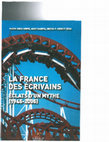
La France des écrivains : éclats d'un mythe littéraire. Marie Odile André, Marc Dambre, and Michel P. Schmitt, eds. Paris: Presses de la Sorbonne Nouvelle, 2011
Une imagination exaltée par l’activisme et par le mythe avait incité de Gaulle à quitter la Franc... more Une imagination exaltée par l’activisme et par le mythe avait incité de Gaulle à quitter la France le 17 juin 1940, pour prononcer le lendemain les paroles devenues légendaires, mais qu’à l’époque peu de Français ont entendues. Dans les studios de la BBC le 18 juin, il a dit deux mots : « la France », puis a entamé le discours qui a fini par créer une nation rebelle à l’occupant allemand et à l’État français de Pétain. Pour Jean-Louis Crémieux-Brilhac, la France libre gaullienne a constitué une interrogation sur le « pouvoir de l’utopie rationnelle en histoire », en dépit de l’« imagerie d’Épinal » des Mémoires de guerre où le Général énoncerait plus tard la « certaine idée de la France » qui avait guidé sa lutte. René Char adopte sciemment le registre mythique pour décrire sa propre résistance dans les rangs de la Section Atterrissage Parachutage (SAP) de la France combattante : le dieu Hypnos veille la nuit sur les maquisards que le poète dirige dans les Basses-Alpes3. Son ouvrage Feuillets d’Hypnos, écrit de 1943 à1944 et révisé en 19454, permet de classer l’ex-surréaliste parmi ceux des Résistants qui, selon l’historien Laurent Douzou, ont « pensé leur action et envisagé ce que l’histoire un jour en retiendrait ».Le portrait d’une nation résistante, ou au moins d’une communauté qui peut se concevoir comme un modèle utopique sinon politique du pays, informe Seuls demeurent (1945), Feuillets d’Hypnos (1946) et la première édition de Recherche de la base et du sommet (1955).
“Du bon usage des ruines : feux croisés de Céline et Volodine.”
Écritures de la guerre aux XXe et XXIe siècles. Eds. Marie-Hélène Boblet and Bernard Alazet. Dijon, France: Éditions Universitaires de Dijon, 2010

“La poésie de René Char: un parcours initiatique des arts de l’espace, du Tombeau des secrets à Recherche de la base et du sommet.”
In Michel Collot, Yves Peyré, and Maryse Vassevière, eds., La bibliothèque littéraire Jacques Doucet: archive de la modernité. Paris: Presses de la Sorbonne Nouvelle et Editions des Cendres, 2007
René Char, ancien surréaliste et résistant, cherchait volontiers, après la Libération, à situer s... more René Char, ancien surréaliste et résistant, cherchait volontiers, après la Libération, à situer sa poésie au sein d'un groupe d’amis et de compagnons créateurs, peintres et poètes d’élite. Il a constitué cette communauté ésotérique d’élus (les « alliés substantiels» et les « grands astreignants ») dans les éditions successives de Recherche de la base et du sommet et dans des «livres de dialogue,» pour adopter l’expression d’Yves Peyré, où la poésie tente de réaliser safusion expressive avec les arts plastiques, le long d’un parcours quasi-initiatique. L'essai suit les étapes de la création de cette commaunauté ésotérique: les photographies et photo-collages de Char, Breton et Eluard dans Le Tombeau des secrets (1930), les gravures de Valentine Hugo qui illustrent Placard pour un chemin des écoliers (1937), les gravures et lithographies de Zao Wou-ki, Maria-Helena Viera da Silva, et Joan Miró dans les livres d'artistes de l'après-guerre. L’identité poétique même de Char est étroitement liée à cette communauté ésotérique, son panthéon d’élus. Sa parole cherche l’image graphique comme “loyal adversaire,” afin de maintenir son propre équilibre parmi le “glissement des abîmes” de l’imaginaire, toute beauté verbale ayant besoin de son partenaire visuel.
"Maurice Papon’s Transition after World War II: A Prefect’s Road from Bordeaux, through Algeria, to Paris (August 1944-October 1961)."
In Richard J. Golsan, ed., The Papon Affair: Memory and Justice on Trial. London: Routledge, 2000
“Yet perhaps the most disturbing theme revealed….with particular force by Van Kelly in his recon... more “Yet perhaps the most disturbing theme revealed….with particular force by Van Kelly in his reconstruction of Papon’s post-war career, is the frequency and oblivious ease with which the clockwork of French technocracy has obscured, suspended, and violated human rights in the interest of expediency and continuity” (Review, Sub-stance 31.1 (2002) : 126-7).

"Suffering and Expenditure: Baudelaire and Nietzsche in Char's Poetic Country"
In Patricia Ward et al, eds. Baudelaire and the Poetics of Modernity. Nashville, TN: Vanderbilt UP, 2000
René Char’s poem “Baudelaire mécontente Nietzsche” (“Baudelaire irritates Nietzsche”), appeared i... more René Char’s poem “Baudelaire mécontente Nietzsche” (“Baudelaire irritates Nietzsche”), appeared in the 1972 collection La nuit talismanique. The title seems to imply that Char incorporates Baudelaire hesitantly into his modern continuum or pantheon. The displeasure or irritation signals a conflict, yet the qualities that Char attaches to Baudelaire and Nietzsche in the opening stanza of the poem seem complementary rather than mutually exclusive: the poet's lucidity amid suffering does not necessarily annul the philosopher's vigorous struggle for self-assertion, going under, and rebirth. At the end of “Baudelaire irritates Nietzsche,” when Char evokes both the philosopher’s “relentless expenditure” and the poet’s “open treasure of the clouds,” he reaffirms his need for a contrast between ecstatic violence and serene contemplation, between furor and mystery, between fusion and distance. In Char’s poetry, Baudelairean stasis, ambiguity, and suffering contest alternative Nietzschean moments of vertigo, frenzy, and empowerment. Baudelaire remains a veiled reference in Char, although Nietzsche retains preponderance as the more modern one, less attached to a past morality and style.
"Criteria for the Epic: Borders, Diversity, and Expansion."
Introduction. Epic and Epoch: Essays on the Interpretation and History of a Genre. Texas Tech University Press., Jan 1, 1994
Is it still possible to read and appreciate - let alone write - epic in the 20th century? Or is e... more Is it still possible to read and appreciate - let alone write - epic in the 20th century? Or is epic a 'fascist' genre, hopelessly compromised by its close association with monarchs and ruling elites? If epic is still to be read. how are we to do so? What are its connections with other genres such as history and the novel?
Articles by Van Kelly
“Difficile Traversée: Dakar, Gorée et les passeurs dans « Barsa, ou barsaq » de J.-M. G. Le Clézio.”
Romans 20-50, 2013

“Ghérasim Luca, Mental Capture, and the Omega Point.”
Sites: Contemporary French and Francophone Studies, 2011
In the Second Manifesto of Surrealism (1929), Breton reoriented the movement's focus toward the “... more In the Second Manifesto of Surrealism (1929), Breton reoriented the movement's focus toward the “supreme” or omega point where opposites including life and death, destruction and construction would no longer be “perceived” as contradictory. This creates a dialogue with later Surrealist poet Ghérasim Luca. Even at his most satirical, Luca pursues his distinct version of the omega point. To surpass its threshold, he uses paronomasia and other sound- and sense-shifting techniques (disarranging and recombining sounds, words, ideas) in order to attack logic's law of contradiction, Cartesian metaphysics, and the Oedipus complex, all at the heart of modern oppressions. Luca attaches his poetics to precursors like Desnos and Leiris who manipulated language with similar liberating impulse.

Jorge Semprun's Broken Mirror: The Broader Text of Resistance, the Shoah, and Camps in L'Écriture ou la vie and Le Retour de Carola Neher
L'Esprit Créateur, Jan 1, 2011
In January 1944, the resister Jorge Semprun was deported from France to Buchenwald. He survi... more In January 1944, the resister Jorge Semprun was deported from France to Buchenwald. He survived to see the camp liberated on 11 April 1945, but did not publish his experience until his first novel, or more precisely his first “autofiction,” Le grand voyage of 1963, which tells of the deportation of “Gérard,” member of a Special Operations Executive (Buckmaster) maquis in Burgundy, though the narration includes segments devoted to the Holocaust per se, notably the S.S.’s brutal execution of a group of Jewish children on their arrival at Buchenwald. The resister’s perspective remains primary in L’évanouissement, with some reference as well to experiences as a clandestine Communist agent in postwar Spain (1978). Subsequently, Semprun published several works on his captivity: Quel beau dimanche (1980), L’écriture ou la vie (1994), Le retour de Carola Neher (1998), and Le mort qu’il faut (2002). These works broaden to embrace many topics: racial deportations, Auschwitz, his family’s involvement in the Spanish Republic, his experience of Buchenwald as “Red Spaniard” protégé of the camp’s German Communist shadow hierarchy, after the liberation his role in the Spanish Communist Party, disillusionment with Marxism, expulsion from the Party in 1964, and critiques of Stalinism and the Gulag, vectors for his own sense of complicity. Semprun’s work echoes Henry Rousso’s chronology of the Vichy Syndrome, but only in part. In L’écriture ou la vie, Semprun recounts the “unfinished mourning” that kept him from writing about Buchenwald more than a decade after his liberation. Moroever, the return of the memory of racial deportations, “la mémoire juive” or beginning of “Obsession” in the Vichy Syndrome, indelibly marks L’écriture ou la vie, overcoming the limited view afforded of the Nazi machine by Buchenwald, deadly but without gas chambers and dominated by political prisoners. By contrast, denunciation of the Gulag, “[l]’ horizon du communisme, incontournable” is Semprun’s version of Rousso’s third stage, the “broken mirror,” and this orientation transcends Vichy and the Syndrome.
Semprun’s broad reach right and left relates directly to his narrative technique. From Le grand voyage onward, he develops an interlocking-ring narration, based on successive flashbacks and flashforwards, where multiple strands of his ethical remembering touch and intertwine, which include, in Part One, Chapters Two and Four of L’écriture ou la vie, extended developments on Kant, Goethe, Blum, Heidegger, Brecht, and the sociologist Maurice Halbwachs. These writerly memory loops with their tangents define Semprun’s ethical crux, which he revisits in Le retour de Carola Neher, performed in 1995 at Weimar. The play expands to include genocides in ex-Yugoslavia, via coincidence with the term “Muslim” or “musulman,” referring to exhausted prisoners on verge of extinction in the Nazi camps. By revisiting his memory sites, Semprun works through to the camps’ wider dimensions.
Semprun conspicuously incorporates repressed Jewish memory in L’écriture ou la vie and Le retour de Carola Neher: Auschwitz evacuees in the Little Camp, testimony on the gas chambers by the Sonderkommando escapee, a Yiddish poem on death and survivorship. But Semprun’s works, beyond the Vichy Syndrome, activate a different memory network as well, the critique of Soviet Communism and of the West’s “propagation du grand mensonge sur les réalités ténébreuses de la société stalinienne” (Goulag 19). Semprun’s intellectual itinerary or loop has two major nexuses. One encompasses WWII, the Resistance, and deportation to the Nazi camps. The other, intersecting only partially with the war, links with the history of Communism from 1917 through 1989. Two deadly universes developed in parallel, each with its rationale for choosing radical evil. As the Bosnian Muslim of Le retour de Carola Neher shows, other nexuses are still possible.
Romanica Gaudensia. Geneva: Droz. Special Issue: À la baïonnette et au scalpel: comment l’horreur s’écrit. Eds. Caroline de Mulder and Pierre Schoentjes, 2009

René Daumal's Exceptional French and Hindu Poetics: Poetry as Inward Theatre, Posture, and Meditation in the Light of Tzara, Desnos, and Dupin
Sites: Contemporary French and Francophone Studies, Jan 1, 2008
René Daumal, in a posthumous essay on Hindu poetics, espoused the Sanskrit notion that “the... more René Daumal, in a posthumous essay on Hindu poetics, espoused the Sanskrit notion that “theatre is the total art” (“Art poétique hindou"). This precept governs Daumal’s conversion of poetry into a drama where the internal persona’s speech, gestures, poses, breath, and voice-stops form a totality. The essay explores how one of Daumal’s last poems, “The Four Cardinal Times” (“Les quatre temps cardinaux”), written in 1943, enacts this inward theatre, in contrast to the kinetic poems of his contemporaries Tzara and Desnos and to those of Jacques Dupin in his very recent collection, Coudrier. The meditative stops inscribed in "The Four Cardinal Times" invite the reader to achieve inward concentration and visualization. The poem is, initially, a noisy theatre, but it leads us to a final circle of silence. The reader is guided to imitate the gestures of the persona saluting the cardinal times, but more significantly he or she is summoned to adopt the final posture within the circle of silence that the fourth strophe inscribes, in order to contemplate the erosion at the heart of life, yet experience a refined sentiment of what Daumal translates from the Sanskrit as “the supreme active Being,” “Me the Fire-of-all-humans...fusing with inbreath and outbreath” (Le contre-ciel).

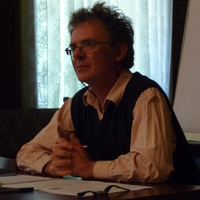



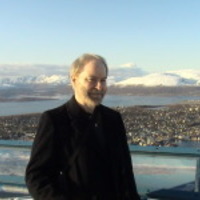



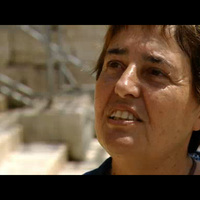

Uploads
Books by Van Kelly
Special Issues by Van Kelly
Digital Humanities Presentation by Van Kelly
Book chapters by Van Kelly
Articles by Van Kelly
Semprun’s broad reach right and left relates directly to his narrative technique. From Le grand voyage onward, he develops an interlocking-ring narration, based on successive flashbacks and flashforwards, where multiple strands of his ethical remembering touch and intertwine, which include, in Part One, Chapters Two and Four of L’écriture ou la vie, extended developments on Kant, Goethe, Blum, Heidegger, Brecht, and the sociologist Maurice Halbwachs. These writerly memory loops with their tangents define Semprun’s ethical crux, which he revisits in Le retour de Carola Neher, performed in 1995 at Weimar. The play expands to include genocides in ex-Yugoslavia, via coincidence with the term “Muslim” or “musulman,” referring to exhausted prisoners on verge of extinction in the Nazi camps. By revisiting his memory sites, Semprun works through to the camps’ wider dimensions.
Semprun conspicuously incorporates repressed Jewish memory in L’écriture ou la vie and Le retour de Carola Neher: Auschwitz evacuees in the Little Camp, testimony on the gas chambers by the Sonderkommando escapee, a Yiddish poem on death and survivorship. But Semprun’s works, beyond the Vichy Syndrome, activate a different memory network as well, the critique of Soviet Communism and of the West’s “propagation du grand mensonge sur les réalités ténébreuses de la société stalinienne” (Goulag 19). Semprun’s intellectual itinerary or loop has two major nexuses. One encompasses WWII, the Resistance, and deportation to the Nazi camps. The other, intersecting only partially with the war, links with the history of Communism from 1917 through 1989. Two deadly universes developed in parallel, each with its rationale for choosing radical evil. As the Bosnian Muslim of Le retour de Carola Neher shows, other nexuses are still possible.
Semprun’s broad reach right and left relates directly to his narrative technique. From Le grand voyage onward, he develops an interlocking-ring narration, based on successive flashbacks and flashforwards, where multiple strands of his ethical remembering touch and intertwine, which include, in Part One, Chapters Two and Four of L’écriture ou la vie, extended developments on Kant, Goethe, Blum, Heidegger, Brecht, and the sociologist Maurice Halbwachs. These writerly memory loops with their tangents define Semprun’s ethical crux, which he revisits in Le retour de Carola Neher, performed in 1995 at Weimar. The play expands to include genocides in ex-Yugoslavia, via coincidence with the term “Muslim” or “musulman,” referring to exhausted prisoners on verge of extinction in the Nazi camps. By revisiting his memory sites, Semprun works through to the camps’ wider dimensions.
Semprun conspicuously incorporates repressed Jewish memory in L’écriture ou la vie and Le retour de Carola Neher: Auschwitz evacuees in the Little Camp, testimony on the gas chambers by the Sonderkommando escapee, a Yiddish poem on death and survivorship. But Semprun’s works, beyond the Vichy Syndrome, activate a different memory network as well, the critique of Soviet Communism and of the West’s “propagation du grand mensonge sur les réalités ténébreuses de la société stalinienne” (Goulag 19). Semprun’s intellectual itinerary or loop has two major nexuses. One encompasses WWII, the Resistance, and deportation to the Nazi camps. The other, intersecting only partially with the war, links with the history of Communism from 1917 through 1989. Two deadly universes developed in parallel, each with its rationale for choosing radical evil. As the Bosnian Muslim of Le retour de Carola Neher shows, other nexuses are still possible.
In the 1938 version of J'accuse!, Jean Diaz had a gaze that could not sever ties to the recent past, since the outbreak of yet another war in the 1930s threatened to be more catastrophic. His only hope for recovery was that, thanks to the imposing return of the dead, the bellicose political configuration necessitating Gance’s version of pacifism would not actually realize its potential for war. Gance’s successive versions of his great film on WWI, like the two versions of Alain’s Mars ou La guerre jugée and numerous related "propos," echo the interwar debates between French pacifist factions studied by historians Norman Ingram and Antoine Prost, but exhibit a preoccupation with peace that events did not resolve. Tavernier, on the other hand, reminds us that the memory of the twentieth century and its mass violence is inextricably bound not just to WWII but to the hecatomb with which our modernity, and its descent into the maëlstrom, disastrously began.
There is a major contrast between Poussin's attitude of artistic retreat from the spheres of influence and power, exemplified in his dyptych of heroic landscapes, "Paysage avec les cendres de Phocion" and "Les funérailles de Phocion," a tragic political story imitated from Plutarch's Parallel Lives, about the vicissitudes and perils of public life and service, and Descartes's masked step onto a center stage he never abandoned intellectually and professionally, despite his self-chosen exile ever farther north in Queen Christina's hyperborean realm. Descartes sought the center from the margins, in order to recolonize it once he had reformed it through his teachings, which have their futuristic as well as their pragmatic side. Through his science (whether in the physics of Le Monde and the Principes de la philosophie, in the various treatises contemporaneous to the Discours, or in the physiology that founds his psychology in Les Passions de l'‚me), he surpasses the prudential humanism of the moraliste classique. Descartes's provisional morality facilitates the search for both scientific and moral truth, and anything that aids this search is defined as the good life, as sagesse. The provisional morality but even more so the method allow him to attempt a wholesale rationalization of human constructive thought and endeavor. As such, Descartes's life work must be considered profoundly utopian, especially given the systematic, exhaustive nature of his philosophical program.
In 1640-1642, Poussin, too, in retuerning to Paris briefly, obeyed the sirens' call to invest the center, but having found it irremediably dystopian, he escaped to adopt finally the margins, ack in Rome, a city of beautiful ruins where a balance between history, fortune, and the individual will was a feasible aspiration. Poussin's itinerary constitutes, at most, the sort of psychological utopia which the utopian critic Kumar (1991) refers to as eupsychia, a region of personal well-being or, in a classicistic context, a prudential retreat from the public life in order to lessen one's exposure to catastrophe and the reversals of chance. The sort of posthumous commemoration that Poussin contrives for Phocion does not create a basis for social reform or aspirations. Instead, the painter seeks through remembrance, criticism, and discreet artistic rectification of the past, to find a code that would allow the individual to understand, and perhaps cope with similar vicissitudes in his own times and in his own limited circle of acquaintances. Despite the apparent ease that suffuses Poussin's urban sites, he is much less utopian than dystopian in vision. In terms of one of his related works, Landscape with Diogenes, Poussin resembles the philosopher who, just outside the polity, discovers the truth of life--follow nature, cup your hands to drink from the stream, abandon the artifice and contention of public life. Behind him lies Athens, beautiful but for a different reason than Rome, because it is an intact symbol of the public life. The cynic, who has already throw down his drinking bowl, rejects at least momentarily the urban center for the sylvan margin. If Poussin aspired to build a utopia, it must have been a painterly one like this, where, as in the gardens of Tivoli, one might withdraw not as a reformer but as an erstwhile observer.
This model of expenditure persists well beyond Resistance and Liberation, into Char's very last poems, which "Riches de larmes (Eloge d'une Soupçonnée, 1988) exemplifies. In "Riche de larmes" is Char produces, in a sense, his own eulogy. By imagining a new dawn, the poet exhibits the force or conflagration that drove the best of his poetry. The rising dawn has burned off some of the vapors and mists of regret that darken much of "Riche de larmes," and the poem becomes a last resistance against the elegiac temptation, a final attempt to work through grief and against melancholy. The sunrise that closes "Riche de larmes" is an answer to the despairing questions that we found at the beginning and midpoint of the poem. The final sunrise in the poem is victory of sorts, even if it is precarious and endangered. As Char writes in "A une sérénité crispée," "Je suis l'imbécile des cendres bien froides mais qui croit un tison quelque part survivant." While the reversal is not as explosive as the youthful awakening to immensity that closes the pre-World War II poem "Donnerbach Mühle," the final site in "Riche de larmes" lights and softly magnifies poetic values which Char strived throughout his career to establish. The poet cannot accept unreservedly the death mask of elegy proper, even in life's waning moments. Instead he chooses to offer us, at the last moment, this burn or sunrise.